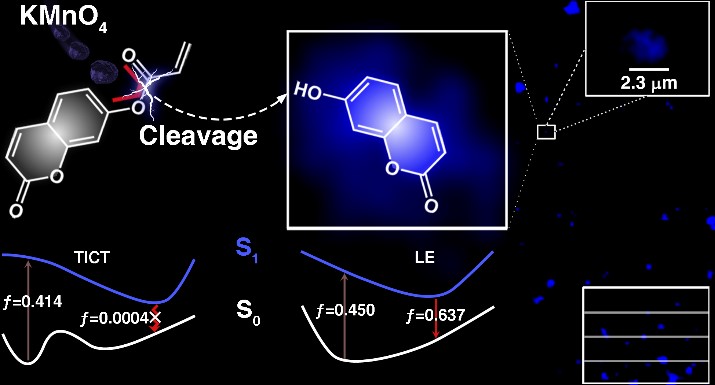Researchers propose a novel methodology that completely inhibits the rotation of barrierless TICT probe for fluorescence-on KMnO4 detection
Editor: | Aug 18,2022
Among the three main modes of qualitative analysis by fluorescent signal, fluorescence-on mode has been widely validated that its relative photon with specific wave character is apparently superior to that of both fluorescence-off and fluorescence-ratiometric, since it results from a stoichiometric binding event rather than from a collisional encounter and completely eliminates the interference of background signals. Up to now, electron, charge and energy transfer mechanisms have been explored and attempted to realize the fluorescence-on model. As an electron transfer process upon photoexcitation, optical signal of TICT is potentially environment-dependent, which makes it an ideal candidate for qualitative analysis. To this end, diverse methods of TICT-based fluorescence-on mode are experiencing a rapid evolution from trial-and-error tactics towards molecular engineering and design-orientated strategies. Thus, according to the specific physicochemical characteristics of target analyte, two fundamental rules of TICT-based probe were proposed for fluorescence-on detection: i) regulating the driving force of electron transfer from donor to acceptor via the utilization of inductive effect; ii) inhibiting the twist of the donor/acceptor via the modification of the steric hindrance. However, whether the TICT formation could be completely inhibited for maximum fluorescence change from even zero signal, namely the barrierless rotation, remains enigmatic and is vitally important for ultrasensitive and robust qualitative analysis. Recently, for challenging this critical issue, Xincun Dou’s group of Xinjiang Technical Institute of Physics and Chemistry, CAS proposed a novel methodology that completely inhibiting the rotation in barrierless TICT probe by directly cleaving the linkage of the donor/acceptor when reacting to specific molecular structure.
To corroborate the feasibility of this proposed methodology, a TICT formation of (2-oxochrome-7-yl) prop-2-enoate (OCPE) was designed for qualitatively analyzing one of the most representative analytes, that is, KMnO4, where extensive uses in organic and analytical chemistry, treatment for skin infections, water disinfection, and construction of improvised explosive devices have caused great environmental disruption and human health risks. Here, the acryloyl group was adopted as an example of the twisting group due to both its high degree of twisting freedom for quenching TICT-based fluorescence and the recognition site of ?C=C? for qualitatively analyzing KMnO4. Featuring the involvement of strong and stable fluorescence emission and good structural flexibility, the typical fluorophore of coumarin was taken as a paradigm to synthesize a TICT-based probe. According to the theoretical simulation of OCPE probe with PBE0-D3(BJ)/6-311G(d,p) level approach, the methodology presented here could be sufficiently verified by calculating the energy potential surface, the hole and electron distributions, and the fragment transition density matrix map throughout the whole process of detecting KMnO4 with OCPE probe. Undoubtedly, the resulting outcomes sufficiently validated the fluorescence-on mechanism of the OCPE probe with great enhancement of φ (0.0461 to 0.5634), a low detection limit toward KMnO4 (0.95 nM, 6.6 pg), a rapid response time (<3 s), and excellent specificity. The practicability of the designed OCPE probe was also verified by the excellent sensing performance for on-site analysis of KMnO4 solution, trace solids, and airborne microparticulates with the help of paper and hydrogel as the carrier. The present work provides a valuable and universal strategy for conceptualizing the fluorescence-on probe, which is highly inspirable for the future development of photochemistry
The research was published in Analytical Chemistry (DOI: org/10.1021/acs.analchem.2c02407) with the title of “Complete Inhibition of the Rotation in a Barrierless TICT Probe for Fluorescence-On Qualitative Analysis”. The co-first authors are Dr. Guangfa Wang and Master Zhixin Wan, and the corresponding authors are Dr. Zhenzhen Cai and Prof. Xincun Dou. The first affiliation of this research is Xinjiang Technical Institute of Physics and Chemistry, Chinese Academy of Sciences. This research was financially supported by Xinjiang International Science and Technology Cooperation Program, Natural Science Foundation of Xinjiang, West Light Foundation of the Chinese Academy of Sciences, National Natural Science Foundation of China, the Youth Innovation Promotion Association, and the Key Research Program of Frontier Sciences.
Article:https://doi.org/10.1021/acs.analchem.2c02407

Design strategy of OCPE probe, detection mechanisms and fluorescence-on detection toward KMnO4 microparticulates
附件下载:
 (86) 991-3838931
(86) 991-3838931 lhskj@ms.xjb.ac.cn
lhskj@ms.xjb.ac.cn (86)991-3838957
(86)991-3838957 40-1 Beijing Road
Urumqi, XinjiangChina
40-1 Beijing Road
Urumqi, XinjiangChina